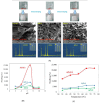Environmental and Wastewater Treatment Applications of Stimulus-Responsive Hydrogels
- PMID: 39852043
- PMCID: PMC11765053
- DOI: 10.3390/gels11010072
Environmental and Wastewater Treatment Applications of Stimulus-Responsive Hydrogels
Abstract
Stimulus-responsive hydrogels have emerged as versatile materials for environmental and wastewater treatment applications due to their ability to adapt to changing environmental conditions. This review highlights recent advances in the design, synthesis, and functionalization of such hydrogels, focusing on their environmental applications. Various synthesis techniques, including radical polymerization, grafting, and copolymerization, enable the development of hydrogels with tailored properties such as enhanced adsorption capacity, selectivity, and reusability. The incorporation of nanoparticles and bio-based polymers further improves their structural integrity and pollutant removal efficiency. Key mechanisms such as adsorption, ion exchange, and photodegradation are discussed, emphasizing their roles in removing heavy metals, dyes, and organic pollutants from wastewater. Additionally, this review presents the potential of hydrogels for oil-water separation, pathogen control, and future sustainability through integration into circular economy frameworks. The adaptability, cost-effectiveness, and eco-friendliness of these hydrogels make them promising candidates for large-scale environmental remediation.
Keywords: adsorption and photodegradation; hydrogel functionalization; stimulus-responsive hydrogels; sustainable water management; wastewater treatment.
Conflict of interest statement
The authors declare no conflicts of interest.
Figures








Similar articles
-
Innovations in cellulose-based hydrogels for enhanced wastewater treatment through adsorption.Int J Biol Macromol. 2025 Apr;303:140660. doi: 10.1016/j.ijbiomac.2025.140660. Epub 2025 Feb 3. Int J Biol Macromol. 2025. PMID: 39909242 Review.
-
Polymeric hydrogels-based materials for wastewater treatment.Chemosphere. 2023 Aug;331:138743. doi: 10.1016/j.chemosphere.2023.138743. Epub 2023 Apr 25. Chemosphere. 2023. PMID: 37105310 Review.
-
Chitosan Hydrogels for Water Purification Applications.Gels. 2023 Aug 17;9(8):664. doi: 10.3390/gels9080664. Gels. 2023. PMID: 37623119 Free PMC article. Review.
-
Polysaccharide-Based Composite Hydrogels as Sustainable Materials for Removal of Pollutants from Wastewater.Molecules. 2022 Dec 5;27(23):8574. doi: 10.3390/molecules27238574. Molecules. 2022. PMID: 36500664 Free PMC article. Review.
-
Revolutionizing wastewater treatment: A review on the role of advanced functional bio-based hydrogels.Int J Biol Macromol. 2024 Oct;278(Pt 4):135088. doi: 10.1016/j.ijbiomac.2024.135088. Epub 2024 Aug 26. Int J Biol Macromol. 2024. PMID: 39197608 Review.
Cited by
-
Polymeric Materials for Wastewater Treatment Applications.Polymers (Basel). 2025 Feb 19;17(4):552. doi: 10.3390/polym17040552. Polymers (Basel). 2025. PMID: 40006214 Free PMC article.
References
-
- Lim S.L., Tang W.N.H., Ooi C.W., Chan E.-S., Tey B.T. Rapid swelling and deswelling of semi-interpenetrating network poly(acrylic acid)/poly(aspartic acid) hydrogels prepared by freezing polymerization. J. Appl. Polym. Sci. 2016;133:9. doi: 10.1002/app.43515. - DOI
-
- Yuan Z., Wang Y., Han X., Chen D. The adsorption behaviors of the multiple stimulus-responsive poly(ethylene glycol)-based hydrogels for removal of RhB dye. J. Appl. Polym. Sci. 2015;132:42244. doi: 10.1002/app.42244. - DOI
-
- Li Y., Yang S., Wang C.-F., Chen S. Facile synthesis of poly(DMC-co-HPA) hydrogels via infrared laser ignited frontal polymerization and their adsorption–desorption switching performance. J. Polym. Sci. Part Polym. Chem. 2015;53:2085–2093. doi: 10.1002/pola.27701. - DOI
Publication types
Grants and funding
LinkOut - more resources
Full Text Sources

